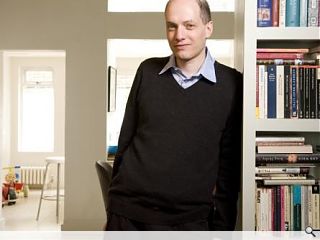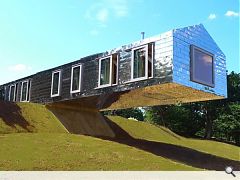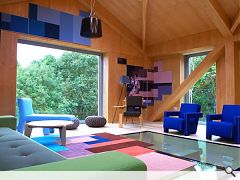Mr Happy
7 Dec 2010
The quest for happiness is one which has eluded humanity for millennia, many have sought out its borders through acquisition of material goods and expanding their bank balances, others seek love or court improbably large friend networks on Facebook. Still others navigate darker paths at the tip of a needle, or the bottom of a bottle but the shifting nature of true happiness make it a state of mind that forever tantalises just beyond the reach of most. One person however believes that this elusive state of being can be distilled from the wispy intangibleness of the never, never to be bottled and corked for perpetuity in our built environment.
In ‘The Architecture of Happiness’ philosopher and entrepreneur Alain de Botton writes that happiness is substantively more than the firing of neurons within our brains. Rather it is a quality which can be built into the very fabric of the buildings around us, harnessing bricks and mortar to capture and solidify those traits which impress themselves upon the psychology of those who find themselves within their presence. In order to achieve this holy grail of architecture it first becomes necessary to define the qualities we hope to effect, it was this very poser which Urban Realm put direct to de Botton when we caught up for a chat. How on earth do we quantify happiness and, moreover, how do we define architecture? “We are by nature anxious creatures, so happiness is a very rare state - it tends to arise when we feel that an inner gift we feel very strongly about has found a way of manifesting itself in the outside world,” said de Botton, adding “Good architecture should be about embedding values we admire and revere into bits of matter - so that we can be reminded, as we go about the business of living, of what counts.”Architecture, notes de Botton, is perplexing in its inconsistent capacity to generate “the happiness on which its claim to our attention is founded. While an attractive building may on occasion flatter an ascending mood, there will be times when the most congenial of locations will be unable to dislodge our sadness or misanthropy.” Regarded as a luxury rather than a necessity by developers and policymakers, perhaps unhappy at the perceived expense of building beautifully, it is a viewpoint which harbours historic precedent in the economic crashes that followed the exuberance of the art deco age or even in some of the capitalist totems which mark many of today’s cities. Diverting economic capital into frivolous adornments isn’t conducive to a healthy economy it seems. In de Botton’s reckoning though “Good architecture should be possible on a relatively limited budget. When it goes wrong, it's almost always a problem of ideas, not cost.” Perhaps then the key to creating a more beauteous environment is not to throw more money at buildings but to conduct a thought experiment into the ideal, perfect, city. If enveloped in perpetual beauty wouldn’t we become numb to its beneficial qualities much as we have to the degradations of our current built environment? Isn’t unhappiness necessary to remind us of what true happiness is? De Botton says “Yes, we might become spoilt with beauty, just as we can become spoilt with anything else. But that shouldn't be an argument for not highlighting the need for beauty. Unhappiness is inevitable, so the key is to make use of it when evaluating happiness and appreciating it. I think that a certain flaw in a person's beauty can highlight their perfections.”
The secret of the idealised city might seem obvious on the face of it; there are several examples globally of successful cities from which to pick and choose after all. One part Paris élan perhaps, add a little New York enterprise with the exuberance of Venice, stir… et voila! If only it were so easy. Noting John Ruskin’s observation in the ‘Stones of Venice’ de Botton singled out the Venetians who set loose upon “perhaps the most beautiful urban tapestry in the world”, chose to indulge “sat in cafes, read the papers, sunbathed, bickered, and stole from one another,” much as their less fortuitous cousins in less
The example of Venice perhaps goes some way to explaining the failures of today’s urban planners to replicate these historic successes. Why should this be? Can’t we distil our rare successes into a repeatable formula of typology, density and material from these numerous exemplars which have proven their conduciveness to happiness by example? “It seems reasonable to suppose that people will possess some of the qualities of the buildings they are drawn to,” says de Botton. Pointing out that if people can “appreciate the play of candlelight against hand decorated tiles” or are “content to lie on the floor tracing the knotted border of an intricate Turkoman rug, then they will know something about patience and stability, tenderness and sweetness, intelligence and worldliness, skepticism and trust.” Of course familiarity with a slew of historical (and contemporary) villains will swiftly divest anyone of such naivety.
De Botton tries to square this circle “We feel happy in environments which bring us things that we lack in ourselves. So as I lack calm, I am extremely sensitive to calming architecture. But others, fearing boredom more, may be more reassured by exuberant baroque styles. Almost everything will one day be a science; it will just take a few thousand more years. The masterpieces of art continue to seem like chance occurrences and artists to resemble cavemen who succeed in periodically lighting a flame, without being able to fathom how they did so, let alone communicate the basis of their achievements to others.”
At heart there is a battle going on between the competing forces of chaos and order, of Canary Wharf and the City if you will. It is perhaps only in reaching the extremities of each that we can appreciate the beauty that lies between. Often the most successful architecture rises from complexity, old meeting new, glass meeting stone or a curve meeting a corner which would not necessarily arise of their own accord from the imagination of an architect or the instinct of a developer but which may naturally arise from a happy confluence of circumstances. Symmetry and precision, noble attributes of themselves are best divined when in the company of disorder, it is in the fractal patterns of nature that the truest form of beauty can be discerned. Mathematically elegant yet fundamentally imprecise chaos theory perhaps illustrates the purest natural law which can inform our own approach to design.
Or maybe in looking at the bigger picture we’ve lost sight of what personable beauty is, after all isn’t there a contradiction in accommodating individual beauty in a field defined by mass consumption? “Mass production isn't the enemy of beauty”, notes de Botton. “After all, most of our emotions are mass emotions, so it makes sense if we can sometimes produce mass things too. Individualism can be overdone.” Can it be that behind the mirage of fashion and culture there are underlying commonalities to beauty? In reply de Botton quotes Stendhal: 'There are as many varieties of beauty as there are of happiness', focus then upon specific examples of past beauty maybe doubly dangerous then, being both irrelevant to today’s needs and as an unnecessary distraction from the multitude of alternative beauties that lie awaiting our discovery.
Corbusier thought to have hit upon a rational approach to beauty, equating the functional with the purer forms of environment. His failure to construct his argument on anything firmer than his own prejudices was born out of an inability to appreciate that beauty evolves in concert with emotion, need and context of the individual. As de Botton says “there is great joy in an object that fulfills its mechanical brief with elegance and austerity.” But, “our sense of what is beautiful is a reflection of what we lack, and as what we lack changes, so our needs for beauty will adjust.” Ultimately we each require a degree of knowledge, interpretation and understanding to fully appreciate beauty but de Botton says “A modest amount of information can help, but the key is simply to open ourselves up to the possibility of feeling.”
Perhaps we are all mere addicts however, chasing the dragon of perfection when we may be better served by pausing to better appreciate that which we have. De Botton states that we can only ever expect, at most, 15min of happiness in any given interval but if our standards and expectations of what is beautiful rise in concert is that really such a bad thing? As de Botton concludes “We owe it to the fields that our houses will not be the inferiors of the virgin land they have replaced. We owe it to the worms and the trees that the buildings we cover them with will stand as promises of the highest and most intelligent kinds of happiness.”
|
|





